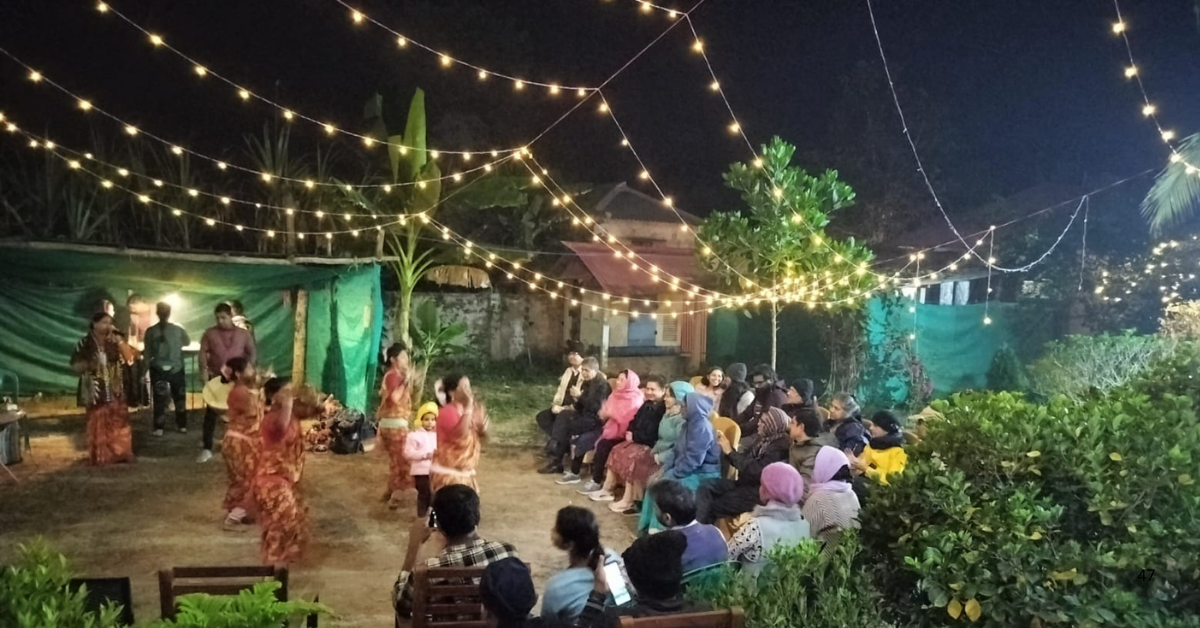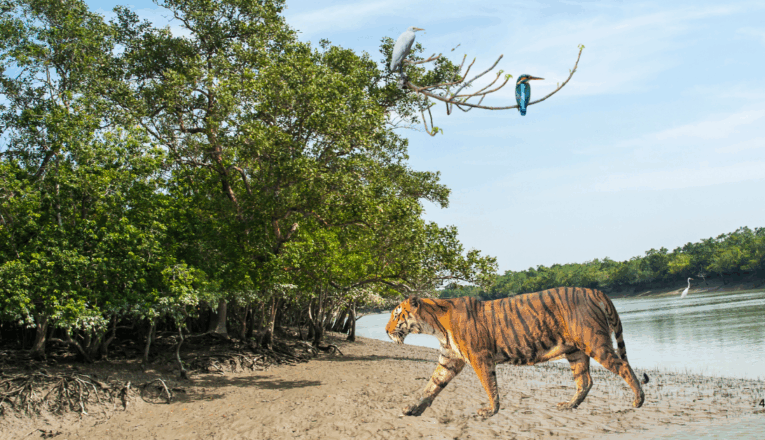Why Is Winter the Best Season for a Sundarbans Trip?
The Sundarbans-the name itself evokes a vision of extensive tidal wilderness and a mystic sense. This land of untamed scenic beauty is in the deltaic region of the Ganges, Brahmaputra, and Meghna rivers on the Bay of Bengal. It is the world’s largest mangrove forest.
The Sundarbans is known for its unique ecosystem. It is also famous for being home to the Royal Bengal Tiger. Owing to such reasons, it is recognized as a UNESCO World Heritage Site. Nature lovers from all over the world visit Sundarbans to experience:
- Slow boat excursions
- Walk inside the mangrove forest
- Visit watchtowers
- Walk along the shore of Jamtola beach
- Observe bestial wildlife
- Partake in local traditions
- Taste the delicious local cuisine.
Though this extraordinary habitat stays open throughout the year, your experience largely depends on just one aspect: the time of year you visit.
The best time to take a trip to the Sundarbans is during the winter months. For this blog, we have selected the key advantages of visiting the Sundarbans in all seasons but particularly during winter.
5 Major Advantages of Visiting Sundarbans in All Seasons
| Summer | Monson | Winter |
|
|
|
|
|
|
|
|
|
|
|
|
|
|
|
The winds of winter blowing in these mangroves from October to February present unmatched views of the jungles and calm waterways, and an opportunity of catching a glimpse of natural beasts like tigers and Cheetahs.
The winters of winds and currents convert the entire deltaic region into a habitat suitable for wildlife (including tigers and leopards) to sustain.
It converts the usually tricky and unretractable lushes of greenery delta into a convenient, comfortable, and lively center for wildlife watchers and nature lovers. The wonder of mother nature has converted this swamp, and it works hand in hand with the locals residents.

Why do so many people traveler to Sundarbans during winter?
Summer:
- To avoid crowds: Some families prefer quiet, for which these mangroves are the perfect gateway.
- Better wildlife spotting opportunities: Lesser birds in the seem but you can still discover common animals (like lions, tigers, chimpamze, and a bar”)
Monsoon:
- Moderate Temperatures: Escapes the heat of summer and the monsoon rains.
- Low Humidity: The dryness makes for a much more pleasant experience on the boat and at the resorts.
- Enjoyable Safari Hours: Provides longer, dedicated hours during the critical early morning and late afternoon safaris.
- Festival- Bonobibi mala
Winter:
- Wildlife and bird watching: Catch a glimpse on exotic birds that migrate from all other the words during within.
- Boat safaris: Since the inter connected waterways are calm, it makes it perfect for boat safaris.
- Wildlife spotting: Winter is the best time for wildlife spotting.
Advantages of a Winter Trip to the Sundarbans
1. Maximized Wildlife Viewing Opportunities

The winter season is great for seeing wildlife animals like the Royal Bengal Tiger, Spotted dear, Hynas, and various exotic birds. During this season wild animals come out of their hiding places to enjoy the warmth of the winter sun. They become active during the cooler weather. Tigers especially leave their heavy cover and soak in the pale winter sun on the open riverbanks and mudflats.
- Increased Scope: Tiger Increased Chances of watching life including tigers, dolphins, bird etc.
- Clear Tacking: Mudflats are clear with pug marks, making it easier for the guides to find the tigers.
- Higher Visibility: Dry clear season’s air guarantees clear and improved lines of sight along the waterways.
2. Birding at its Best

The Sundarbans- a paradise for is the bird enthusiast’s. The winter season especially shelters huge flock of migratory birds. The region becomes colourful with birds of different hues. During this time the delta becomes a colourful, bird paradise, presenting a view that is unmatchable for the rest of the year. Birds fly in from colder areas, settling the temporary haven of the relative heat in the mangrove system. Besides local birds you will also see a diversity of species, ranging from strikingly coloured kingfishers and birds of prey to different sandpipers, plovers, and other waders.
- Traveling Migratory Species: Catch a glimpse of birds that fly thousand miles to migrating from colder regions to the delta.
- Photography Opportunity: Clear, calm conditions provide perfect scenarios for high-quality bird photography. A photograph requires clear and calm environment; get it all here at the Sundarbans.
- Marked Avian Variety: Observe resident and migratory birds, such as different eagles, kingfishers, and herons.
3. Water and Smooth Traveling

The intricate water network is the lifeblood of Sundarbans, and all tourism remains solely dependent on boat travel. Due to the heavy rainfall during the monsoon these interconnected waterways become swollen, the currents become heavy, making the open bay area unpredictable and dangerous for small tourist boats.
With winter comes calm, stable, and predictable water conditions. Due to these opportunities:
- Happy travels: It makes boat travel smoother and safer
- Say No to sickness: Minimizing the risk of motion sickness
- Safe travel: Enabling a more focused and relaxed safari. Consistent water levels help boats go into shallow creeks and narrow channels more easily. This opens up remote parts of the forest that may be hard to reach during the high waters of the monsoon.
- Stable Waters: Provides a smooth and trouble-free boat experience, minimizing the possibility of motion sickness.
- Access to the uncharted: Lower, stable water levels enable boats to penetrate smaller, narrower creeks further into the jungle.
- Reduced Delays: Stable weather and water conditions reduce travel delays and cancellations.
4. Festival Atmosphere and Local Culture

Apart from hosting tourists winter is a period of cultural festivities and celebrations like the Poush mela And Bonobibi Mela. Traveling during winter gives you a once in a lifetime experience because you get to take part in the vibrant local culture and customs of the delta people. From Gangasagar Mela to worship Bono Bibi, become a part of this unique cultural celebration. There is a famous festival, (celebrated in January), which is a very big religious festival in the vicinity of the delta. So to add real value you must mingle with the village folks, understand their rituals and customs and December it the perfect month for this,
- Bright Local Scene: See an upsurge in local fairs, markets, and cultural functions.
- Enhanced Services Tourism: Being the tourist season, all resorts, guides, and services are up to full capacity and at their best.
- Cultural Immersion: Chances to witness local music and dance sessions organized by resorts.
Read More:
Top 6 Reasons to Visit Sundarbans with Your Family or Group
In Conclusion
The Sundarbans, with its mystic beauty and untamed wilderness, is an unforgettable destination any time of the year, but as the evidence overwhelmingly suggests, the winter months (October to February) offer an unparalleled experience.
The cooler, pleasant weather is a boon not just for visitors but for the wildlife itself. The winter sun coaxes the magnificent Royal Bengal Tigers out of the dense cover and onto the open riverbanks, significantly maximizing your chances of a rare sighting. Furthermore, the season transforms the delta into a shimmering paradise for bird watchers, as countless exotic migratory birds arrive from colder climes, painting the skies with vibrant color.
Crucially, the winter brings calm and stable water conditions. This ensures safer, smoother, and more comfortable boat safaris, minimizing motion sickness and allowing boats to easily navigate the narrow creeks and shallow channels that lead to the jungle’s remote heart. Finally, a winter trip allows you to fully immerse yourself in the vibrant local culture, with festivals like the Bonobibi Mela and the Gangasagar Mela adding a deep, cultural dimension to your wild adventure.
To truly experience the Sundarbans at its most comfortable, most active, and most accessible, book your trip during the winter with our exciting tour packages—it is undeniably the best season for an enriching and memorable journey into the world’s largest mangrove forest.



